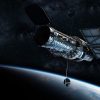Within the next ten years, we’re hoping to have people living forever on the Moon and might even be creating the first attempt to land human beings. Despite this push toward interstellar exploration, there is a good deal about the world around us a lot we do not even know to ask about however, and which we do not know. On top of that, much of the data we could be amassing from outer space is invisible to the eye. What resources are for Every JobWe rely on satellites these days for everything from navigation scientists using to collect data in space?A Satellite. Some, like SpaceX’s Starlink satellites, will eventually be able to give the whole globe by means of a constellation of 12,000 satellites with internet, starting 60 CubeSats. Satellites are good for more than simply supplying us with GPS data, however — there’s a satellite out there for virtually every job, including collecting data about outer space.The Hubble Space Telescope has been orbiting since 1990, also at the past 30 years has collected untold numbers of gorgeous imagery of remote galaxies, nebulae, and planets which we would not have been able to see with the naked eye. Fix, we have sent missions up to upgrade and handle this orbital telescope.What can you really do which you ca catch with a crewed spacecraft? NASA is working on a solution — using autonomous robots while they are in orbit, to grapple with these satellites. They can be secured with high-tensile-strength wires which allow the grappling robot to refuel the satellite and even carry out repairs. Until today, once a satellite broke down or ran out of gas, it was left to drift or allowed to burn up in the Earth’s atmosphere. Now, businesses which own satellites will be able to extend their lifespans exponentially, becoming a part of the trend of renewable spaceflight technology.Seeing the InvisiblePictures might be worth 1000 words, but there is so far in the world we can’t see with the naked eye because it’s not about the visible light spectrum. That does not mean it is not important, however! In reality, looking at matters like radio and infrared waves might help us paint a picture of the world that we might never be able to observe otherwise.Researchers can equip satellites in orbit with sensors and detectors that look for everything from radio waves to microwave radiation and even gamma rays from distant exploding stars. The majority of the world’s electromagnetic radiation makes it to the surface of the planet, so if you’re relying on ground-based sensors, you’re passing up a lot of potential discoveries.Satellites, particularly those put in high orbits or outside the Earth’s purview entirely, supply scientists with an unobstructed view of the world. NASA is considering putting a radio telescope on the dark side of the moon because it might allow scientists to see things that orbiting satellites might miss, using the bulk of our closest satellite for a shield to block EM interference in the planet below.It is not Always ComplicatedHigh-tech sensors and data collectors might seem like the arrangement of the afternoon when it has to do with gathering data in outer space, but it does not always have to be complicated. The astronauts were using handheld tongs, rakes, shovels and hammers to take samples and collect moon rocks to deliver home.Our new technologies enables us to see things which the Apollo astronauts might not have been able to imagine, but sometimes the best instrument is as simple as a hammer or even a set of tongs.A Job for Your RobotsMars is now the sole planet in the solar system that is totally inhabited by robots. That might change in the next ten years or so as we begin to make our way to the Martian surface, except for the moment, Curiosity and rovers like it will be the sole life on the planet.This is merely the first illustration of the potential use of robotics for collecting data in outer space. We can send robots to the edges of the solar system and outside, and far out to regions where humans explorers can’t survive, such as the caustic surface of Venus. NASA sent two CubeSats — nicknamed Eva and Wall-E following the Disney/Pixar film characters — along with the InSight lander that launched at 2019. In reality, many facilities and researchers are turning to taxpayer scientists — casual distance fans who might not have a diploma but possess a passion for astronomy — to help them examine outer space, collecting data and processing it quicker than trained teams could in their own.It’s no substitute for trained engineers and astronomers, but it can be a fantastic way to get the public involved in something which may otherwise seem completely out of reach. There are loads of tools online, both via NASA and other space agencies, that aspiring astronomers can use to have a feel for the industry while they assist researchers around the world navigate massive datasets.We’re Still LearningWe have made significant advances in just about any tech sector in the years since the moon landings, but when it comes to space travel, we’re essentially toddlers taking our first steps. We may never learn all of the world’s secrets but that will not prevent us from vexing out and turning over every rock that is celestial.
– Advertisement –

